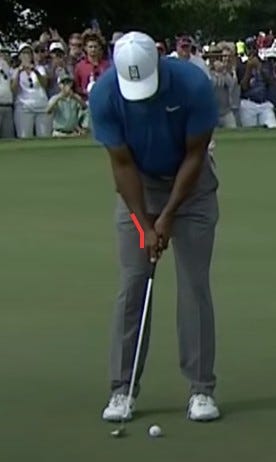Putting Mechanics 101
Level 4- Brooksy
Welcome Avatar! Last post we covered *all* of the important aspects of playing the game, providing a roadmap to Degen Island CC. Now we’ll get into the details of the ideal putting stroke. While it is the simplest motion in golf, the putting stroke has caused an immense amount of frustration for all caliber of players. Because his technique is perfect, we’ll use Tiger Woods as our putting-stroke model.
Before we get into the how, let’s start off with the components of a perfect stroke.
Square Face and Path at Impact: Hopefully this is self-explanatory. We want to start the ball exactly where we aim; best way to do it is to come into impact with a square face and a path moving exactly down the target line.
Equator of ball struck on middle of the blade: Both vertically and horizontally. If we can strike the center of the putter-head the majority of the time, speed control is immensely easier as well as directional control (off-center hits destabilize the putter-head). Also, center contact vertically (halfway between the bottom and top of the putter) is a big factor in putting a pure roll on the ball.
Slightly inside going back, down-the-line going through: This excludes longer putts. A slight arc to the inside on the backswing is natural due to our anatomy and the way putters are constructed. Down-the-line in the follow through promotes a square path and release of the putter-head.
Clubface square to path in backswing and through impact, closed to path in the follow through: Allowing the putter-head to open up in the backswing promotes a smooth, natural stroke. Generally, the more you can let the putter swing itself, the better. Allowing the putter-head to close in the follow-through (called the release) is critical for putting a good roll on the ball by promoting a high-draw feel.
Angle of attack 1-2 degrees up on the ball: Causes a pure roll. Putters generally have 3-4 degrees of loft on them to compensate for the ball sitting in a very small crater of its own making. Hitting up on the ball slightly leads to the golf ball having zero backspin or topspin (each of which cause skidding or bouncing), while still getting up and out of its own crater.
Overall, clubhead stays low to the ground throughout the stroke: Exception for long putts. Makes path and contact more consistent, leads to better tempo and rhythm, and helps tremendously on left-to-right putts (for right-handed players).
Top of follow-through slightly higher than top of backswing: Result of hitting slightly up on the ball.
Backswing and Downswing roughly the same length: We consider this vital for consistency and speed control.
Backswing and Through-swing (downswing + follow-through) take roughly the same amount time: Helps a ton with speed control. In the past, we’ve used a metronome to train this aspect. Simply counting off “1……2” while making a stroke will get the job done. Tempo is up to you.
We know this seems like a lot, but these all add up to something very simple…
Setup
Having a great set-up increases the chances of making a great stroke.

Eyes over the ball or just inside it: Makes it easy to see the starting line. If you have your eyes outside of the ball, it induces an outside-in putting stroke with an open face. To check, simply put a golf ball up to your eyes and drop it straight down, then either place it where it lands or roll it half-an-inch to an inch away from you.
Forearms roughly in-line with the angle of the club-shaft: Makes the forearms an extension of the putter-shaft, making an optimal stroke easier to execute. There is some room for variation however. We tend to have our forearms slightly more vertical than the shaft-angle.
Simple trick: Stand up straight, grip the putter, bring the club-shaft horizontal with the ground, make sure your forearms are also horizontal, then bend over. You’ll have to angle your wrists slightly downward (LINK).
Slightly Open or Square Stance: We prefer a slightly open stance; makes it easier for the arms to swing freely. Width of the stance is up to your preference, although we prefer the feet sitting directly under the hips.
Ball position somewhere between middle of stance and inside of front foot: Sets up a slightly upward angle of attack. We prefer under left-eye (for righties); if you want to replicate, you can take a golf ball, put it up to your left eye, then drop it and place it at the landing spot.
Hips, shoulders, forearms and eyes parallel to the starting line: Any misalignment will throw off the path of your stroke. Check by putting an alignment stick or a club across your hips/shoulders/forearms and see if they are aligned parallel to your starting line.
Neutral posture w/ relaxed shoulders: Not standing straight up, not overly bent over. It’s actually good technique to let the top of the back round slightly because it reduces tension in the shoulders, creating a smoother stroke. We also like the left shoulder slightly higher than the right (for right-handed players), but it’s a matter of preference.
Slight knee flex: For stability purposes.

Hands either in-line with the golf ball or very slightly ahead: Creates a slight forward shaft lean. Reduces the loft on the putter from 3-4 degrees to 1.5-3, which helps with creating a zero spin launch. Also seems to aid in consistency.
Sole of the putter laying flat on the ground: Some putters are designed for the toe to be slightly up, but generally the bottom part of the middle of the blade should be flat. Since the putter has loft on it, a putter with the toe or the heel sitting higher than the other will cause the ball to launch off line. Of course, there are exceptions to this rule, the most notable being Steve Stricker (heel up).
To implement, either have someone take a photo or a video from down-the-line or face-on, or just practice your set-up in a mirror or a window.
Grip
This will depend on the person, as there are plenty of different grip styles out there. We’ll use an asterisk (*) to mark what should be used no matter what style of grip.
*Thumbs running directly down the club-shaft / grip: Critical for having the hands square to the putter-face. Most putter grips are square on the top, rather than rounded all the way.
*Palms facing each other: Makes it so neither hand dominates the other.
Prefer reverse-overlap. Tip of the overlapping left index finger rests between middle and ring finger of the right hand. Copied from Tiger.
Nail of left thumb rests directly under the base knuckle of the right thumb: Just a preference. We find this helps the connection between the right and left hand.
*Grip pressure- prefer between 4-6 on a scale from 1 to 10: We go with a 3 from time to time. Helps promote feel and fluidity in the putting stroke. Fluidity overall is a huge key to consistency.
Stroke Mechanics
Of what we talked about in the first section, here are the main ways those can all be attained.
Maintain arm structure: There’s a triangle that forms between your shoulders and arms at address. Rocking your shoulders and swinging your arms back and forth allows you to maintain this structure throughout the stroke.
Swing the tip of the right thumb back and forth: This is a useful heuristic. Every putt is essentially a long tap-in. For tap-ins, the hands move a very small amount. By taking this thought, and extending it, we can simplify the stroke quite a bit. We are right-hand dominant putters, so we think about the right hand most of the time.
Feel soft connection between the upper portion of the left arm and just under the left armpit: Maintain this throughout the putting stroke, and especially into the follow-through. Combined with maintaining the structure of the arms, the release of the putter takes care of itself, with the toe passing the heel. This is the best putting tip we know.
Maintain the angle in right wrist: Helps keeping the blade square and the hands mostly out of it. Autist note: Ben Crenshaw and Tiger Woods are ok with a bit of wrist movement.
Allow the putter-head to swing freely and smoothly: Lighter grip pressure helps in this regard. The freer the putter swings, the more consistent the face angle will be. It’s optimal for the putter-head to get a bit behind the hands in the backswing and pass the hands in the follow-through (below). Let the putter do the work.

Keep your head still until well after the ball has left: Can’t tell you how many strokes this has saved us. After impact, you’ll see a brief shadow / negative image of where the ball was previously. That’s how you know you’ve kept your head down long enough. On short putts, we like to keep our head down until the ball hits the bottom of the cup, not even watching it go in.
Keep the putter-head low going through the ball and into the follow through: As stated beforehand, helps with consistency and especially left-to-right putts, which are typically more difficult for right-handed players (vice versa for lefties).
Backswing and follow-through should be roughly the same length: Helps tremendously with controlling speed, as it holds a variable constant for all putts. A big part of improvement is reducing the number of variables that change.
Hold the finish for at least half a second; head, putter, everything: Ensures that you focus on making a good stroke, rather than concerned with where the ball is rolling off the putter.
Yes, this is a lot. Don’t try to focus on all of these at once (exception for set-up). Pick a few for the next time you practice and play, and you will see an immediate improvement in your putting stroke.
We’ll go over a ton of drills you can do implement technical changes to your stroke in the next substack.
Degen Island Country Club awaits you, anon.








